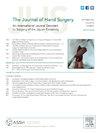Range of Motion Following Flexor Tendon Repair: Comparing Active Flexion and Extension With Passive Flexion Using Rubber Bands Followed by Active Extension
IF 2.1
2区 医学
Q2 ORTHOPEDICS
引用次数: 0
Abstract
Purpose
This study aimed to compare the outcome in terms of range of motion between early active flexion and extension (early active motion, [EAM]) and passive flexion using rubber bands followed by active extension (sometimes referred to as a Kleinert regimen) after flexor tendon repair in zones 1 and 2.
Methods
Data were collected from the Swedish national health care registry for hand surgery (HAKIR). Rehabilitation regimens were decided by the preference of each caregiver. At 3 months, 828 digits (656 EAM and 172 passive flexion) and at 12 months, 448 digits (373 EAM and 75 passive flexion) were available for analysis. Thumbs were analyzed separately.
Results
No notable difference in total active motion was found between the groups at 12 months of follow-up.
Conclusions
This large registry study supports the hypothesis that EAM rehabilitation may not lead to better range of motion long-term than passive motion protocols.
Type of study/level of evidence
Therapeutic IV.
屈肌腱修复后的活动范围:比较主动屈伸与使用橡皮筋被动屈伸,然后再进行主动伸展。
目的:本研究旨在比较屈肌腱修复术后1区和2区早期主动屈伸(早期主动运动)和使用橡皮筋被动屈伸后主动伸展(有时称为Kleinert疗法)在运动范围方面的效果:数据收集自瑞典全国手部手术医疗登记处(HAKIR)。康复方案由每位护理人员自行决定。3个月时有828个手指(656个EAM和172个被动屈曲),12个月时有448个手指(373个EAM和75个被动屈曲)可供分析。对拇指进行了单独分析:结果:随访 12 个月时,两组在总主动运动方面没有发现明显差异:这项大型登记研究支持这样的假设,即与被动运动方案相比,EAM 康复可能不会带来更好的长期运动范围:治疗 IV.
本文章由计算机程序翻译,如有差异,请以英文原文为准。
求助全文
约1分钟内获得全文
求助全文
来源期刊
CiteScore
3.20
自引率
10.50%
发文量
402
审稿时长
12 weeks
期刊介绍:
The Journal of Hand Surgery publishes original, peer-reviewed articles related to the pathophysiology, diagnosis, and treatment of diseases and conditions of the upper extremity; these include both clinical and basic science studies, along with case reports. Special features include Review Articles (including Current Concepts and The Hand Surgery Landscape), Reviews of Books and Media, and Letters to the Editor.

 求助内容:
求助内容: 应助结果提醒方式:
应助结果提醒方式:


